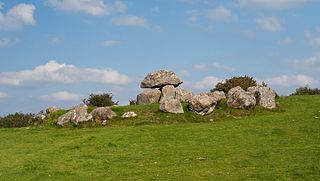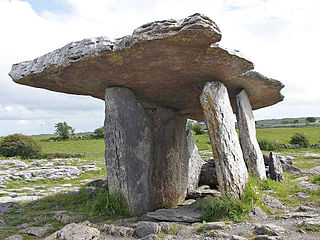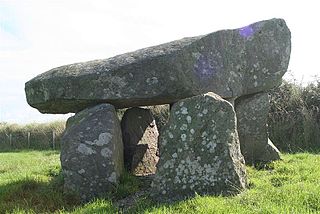
Presaddfed Burial Chamber is a listed monument in Anglesey, north Wales, comprising two Neolithic chamber tombs. It is a scheduled ancient monument and is located a short distance northwest of Bodedern. It is maintained by Cadw.

Presaddfed Burial Chamber is a listed monument in Anglesey, north Wales, comprising two Neolithic chamber tombs. It is a scheduled ancient monument and is located a short distance northwest of Bodedern. It is maintained by Cadw.
There are two neolithic tombs at this site, which is located about 100 m (330 ft) south of Llyn Llywenan and about 1 km (0.6 mi) northwest of the village of Bodedern. The southern tomb is the more complete; it has a capstone some 4 by 3 m (13 by 10 ft), supported by three stout upright stones at the south end and by a single more slender stone at the north. Additionally there is a wooden frame beside the north upright that may provide some additional support. The northern tomb is considerably damaged with two remaining uprights at the north end; the capstone has fallen and is leaning against them. During the eighteenth century, when this site was first recorded, the northern tomb was already in a state of disrepair. It is unclear whether these chambers, which are only a few metres apart, were part of the same structure or were independent. A report in The Archaeological Journal in the mid-nineteenth century states that at that time the chambers were surrounded by a large number of small stones. Nowadays, this stone debris is no longer visible, but its former presence may indicate that at one time, both chambers were buried under a single mound, as is the case in the multi-phase burial tomb at Trefignath, some 9 km (6 mi) west of Presaddfed. [1]
Presaddfed was described by Richard Gough in his 1798 version of William Camden's topographical survey Britannia. [2] It was described in numerous nineteenth century articles in Archaeologia Cambrensis , and was included in J.E. Griffiths' 1900 book, 'A Portfolio of Photographs of the Cromlechs of Anglesey and Caernarvonshire'. [2] Early reports suggest quantities of cairn material surrounded the cromlechs, which is no longer evident, so may have been removed in the nineteenth century. There appears not to have been any formal archaeological excavation on the monument. [2] The monument now has legal protection as a Scheduled Monument, and is in the care of the state, managed by Cadw under a Guardianship agreement. [3] The Royal Commission on the Ancient and Historical Monuments of Wales curates the archaeological, architectural and historic records for the site. These include digital photographs, colour and black and white photographs, drawings, NMR site files, and Cadw guardianship records. [4]
About half a mile east of the burial chamber, on the ridge between Tre-Iorwerdd and Presaddfed, there is a tumulus with a circumference of about 55 m (60 yd). It was excavated in 1870 and a jet bead and cremation urns were unearthed. [5]
The HeritageTogether project [6] has used photogrammetry to create 3D models of the site. [7]
The site is open to the public, free of charge, throughout the year, save for 24, 25, 26 December and 1 January. Access is through a kissing gate and across a grassy field, a distance of about 200 m (700 ft), and there is a pull-in by the roadside which is large enough for two cars. [8]

A megalith is a large stone that has been used to construct a prehistoric structure or monument, either alone or together with other stones. There are over 35,000 in Europe alone, located widely from Sweden to the Mediterranean sea.

Bodedern is a village and community in the west of Anglesey, Wales. At the 2001 census, it had a population of 1,074, decreasing slightly to 1,051 at the 2011 census. The community includes the settlements of Llanllibio and Pen-llyn.

Bryn Celli DduWelsh pronunciation: [brʌn keːɬi ðɨː] is a prehistoric site on the Welsh island of Anglesey located near Llanddaniel Fab. Its name means 'the mound in the dark grove'. It was archaeologically excavated between 1928 and 1929. Visitors can get inside the mound through a stone passage to the burial chamber, and it is the centrepiece of a major Neolithic Scheduled Monument in the care of Cadw. The presence of a mysterious pillar within the burial chamber, the reproduction of the 'Pattern Stone', carved with sinuous serpentine designs, and the fact that the site was once a henge with a stone circle, and may have been used to plot the date of the summer solstice have all attracted much interest.

Carrowmore is a large group of megalithic monuments on the Coolera Peninsula to the west of Sligo, Ireland. They were built in the 4th millennium BC, during the Neolithic. There are thirty surviving tombs, making Carrowmore one of the largest clusters of megalithic tombs in Ireland, and one of the 'big four' along with Carrowkeel, Loughcrew and Brú na Bóinne. Carrowmore is the heart of an ancient ritual landscape which is dominated by the mountain of Knocknarea to the west. It is a protected National Monument.

Bodowyr Burial Chamber is a Neolithic burial chamber made of a few large stacked stones in a farmer's field on the north Wales island of Anglesey. It is located at Bodowyr Farm, 1.25 mi (2.0 km) east of Llangaffo, off the B4419 road.

Poulnabrone dolmen is an unusually large dolmen or portal tomb located in the Burren, County Clare, Ireland. Situated on one of the most desolate and highest points of the region, it comprises three standing portal stones supporting a heavy horizontal capstone, and dates to the Neolithic period, probably between 4200 BC and 2900 BC. It is the best known and most widely photographed of the approximately 172 dolmens in Ireland.

Pentre Ifan is the name of an ancient manor in the community and parish of Nevern, Pembrokeshire, Wales. It is 11 miles (18 km) from Cardigan, Ceredigion, and 3 miles (4.8 km) east of Newport, Pembrokeshire. Pentre Ifan contains and gives its name to the largest and best preserved neolithic dolmen in Wales.

The dolmens of Jersey are neolithic sites, including dolmens, in Jersey. They range over a wide period, from around 4800 BC to 2250 BC, these dates covering the periods roughly designated as Neolithic, or “new stone age”, to Chalcolithic, or “copper age”.

Ambleston is a village, parish, and community in Pembrokeshire, Wales, lying seven miles (11 km) north-north-east of Haverfordwest. The parish includes the hamlets of Wallis and Woodstock.

Tinkinswood or its full name Tinkinswood Burial Chamber, also known as Castell Carreg, Llech-y-Filiast and Maes-y-Filiast, is a megalithic burial chamber, built around 6,000 years ago, during the Neolithic period, in the Vale of Glamorgan, near Cardiff, Wales.

Lligwy Burial Chamber is a Neolithic burial chamber in Lligwy, near the east coast of Anglesey, Wales, United Kingdom. It consists of a circle of upright stones, made into a low chamber by a very large roof slab estimated at 25 tonnes. Excavation in 1909 found the remains of some 15 to 30 people, and pottery suggesting a late Neolithic date. Close to the village of Moelfre, the site is within a few metres of the road, where there is room to leave a single car for short periods.

The St Lythans burial chamber is a single stone megalithic dolmen, built around 4,000 BC as part of a chambered long barrow, during the mid Neolithic period, in what is now known as the Vale of Glamorgan, Wales.

Parc Cwm long cairn, also known as Parc le Breos burial chamber, is a partly restored Neolithic chambered tomb, identified in 1937 as a Severn-Cotswold type of chambered long barrow. The cromlech, a megalithic burial chamber, was built around 5850 years before present (BP), during the early Neolithic. It is about seven 1⁄2 miles (12 km) west south–west of Swansea, Wales, in what is now known as Coed y Parc Cwm at Parc le Breos, on the Gower Peninsula.
Sperris Quoit is a ruined megalithic burial chamber or dolmen, and one of a type of tomb unique to West Penwith, located on a moor around 365 metres northeast of Zennor Quoit, being roughly halfway between Zennor and Amalveor, Cornwall. It is the northernmost quoit in the Penwith peninsula and a Scheduled Monument.

The Grey Mare and her Colts is a megalithic chambered long barrow located near Abbotsbury in Dorset, England. It was built during the Early and Middle Neolithic periods. The tomb was partially excavated in the early nineteenth century, and was found to contain human bones and several pottery fragments.

Tŷ Newydd Burial Chamber is a Neolithic dolmen located northeast of the village of Llanfaelog on the Isle of Anglesey in Wales. It is located near Tŷ Newydd farm, and is in the care of Cadw.

Din Dryfol is a Neolithic burial chamber on Anglesey, in Wales. It is a scheduled monument and is maintained by Cadw. The monument is near Bethel. Three phases of use have been identified, all dating from the Neolithic period.

Trefignath is a Neolithic burial chamber near Trearddur, south of Holyhead on Holy Island, off Anglesey in Wales. In its most complete form it included a large cairn covering three stone tombs, set on a small knoll. It was excavated between 1977 and 1979, revealing several phases of occupation with three separate burial chambers built in succession. It is a scheduled ancient monument, maintained by Cadw.

Pant-y-Saer is a Neolithic dolmen near the small town of Benllech in Anglesey, Wales. This burial chamber is partially collapsed with the massive capstone resting on the ground at one end. The remains of fifty-six people who were buried here have been found during excavations.

Perthi-Duon Burial Chamber is a Neolithic dolmen located to the west of Brynsiencyn, Anglesey, Wales.